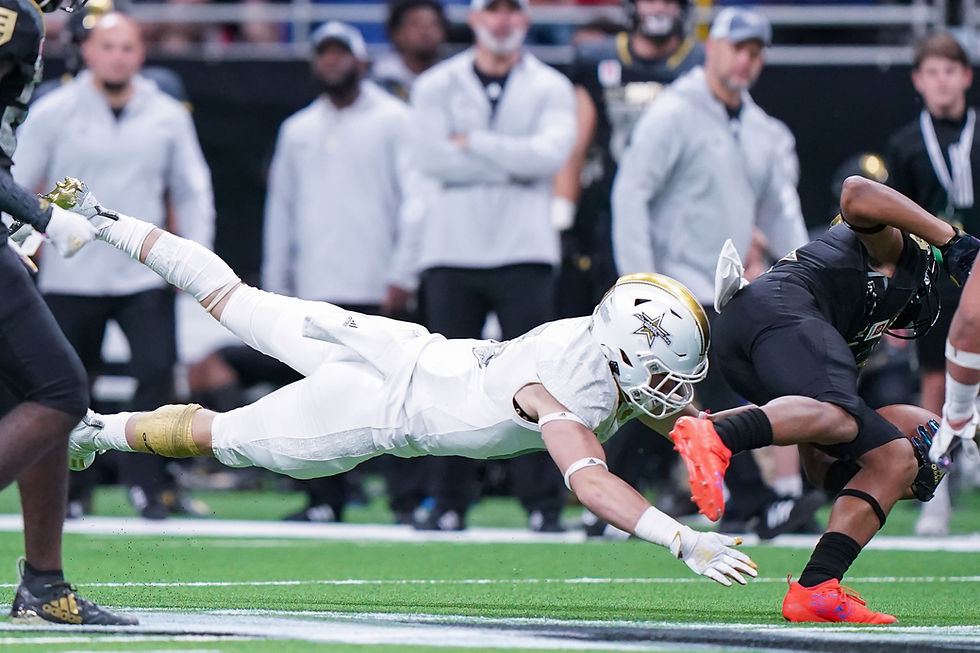Navigating the Gridiron: Unveiling High School Football's Greatest Challenges
- Ayden Hector
- Apr 4, 2024
- 3 min read
High school football in America holds a special place in the hearts of many. It's a quintessential part of the American experience, where young athletes learn teamwork, perseverance, and the thrill of victory. However, behind the Friday night lights lie a series of challenges that coaches, players, and communities face year after year. From the locker room to the field, high school football presents a unique set of hurdles that shape the sport and those involved in it.
Financial Constraints
One of the foremost challenges facing high school football programs is financial strain. Despite being deeply ingrained in American culture, funding for high school sports often needs to be improved. The costs associated with equipment, field maintenance, transportation, and coaching staff salaries can be substantial, especially for schools with limited resources. As a result, many programs need help to provide adequate resources for their teams, hindering player development and overall program success.
Safety Concerns
With growing awareness of sports-related injuries, particularly concussions, safety concerns loom large over high school football. Coaches and administrators must navigate the delicate balance between fostering a competitive spirit and prioritizing player welfare. Strict protocols for injury prevention, concussion management, and proper equipment fitting are essential but can also pose logistical challenges for under-resourced programs. Ensuring the safety of young athletes remains a top priority, requiring ongoing education and adherence to best practices.
Recruiting and Retention
Recruiting talented players and retaining them throughout their high school careers present significant challenges for football programs. Competition from neighboring schools, as well as other sports and extracurricular activities, can lure prospective athletes away from the gridiron. Moreover, maintaining player interest and commitment amid academic pressures and personal obligations requires effective communication and mentorship from coaches and staff. Building a cohesive team and sustaining a winning culture hinges on the ability to recruit and retain dedicated players.
Academic Expectations
Balancing academic responsibilities with the demands of football season is a perpetual challenge for student-athletes. High school football players are expected to excel both on the field and in the classroom, often facing rigorous academic standards and time constraints. Juggling practice schedules, game days, and travel commitments with homework assignments and exam preparation requires discipline and time management skills. Coaches and educators play a pivotal role in supporting student-athletes academically, emphasizing the importance of education alongside athletic achievement.
Community Support
The success of high school football programs relies heavily on community support and engagement. From fundraising efforts to game attendance, the involvement of parents, alumni, and local businesses is vital for sustaining program viability. However, garnering community support can be challenging, especially in areas where competing interests or economic hardships overshadow the significance of high school sports. Building strong relationships with stakeholders and fostering a sense of pride and belonging within the community is essential for the long-term success of high school football programs.
Equity and Inclusion
Ensuring equitable access to football opportunities for all students, regardless of socioeconomic status or background, is a pressing concern within high school athletics. Historically, disparities in resources and opportunities have disproportionately affected underserved communities, perpetuating inequities in sports participation and success. Efforts to promote diversity, equity, and inclusion in high school football require proactive measures, such as scholarship programs, outreach initiatives, and inclusive team policies. Creating an environment where every student feels valued and supported is essential for the integrity and growth of the sport.
High school football embodies the spirit of camaraderie, perseverance, and community pride. However, the journey from the locker room to the field is riddled with challenges that test the resilience of coaches, players, and communities alike. From financial constraints and safety concerns to academic expectations and equity issues, navigating the gridiron requires dedication, creativity, and unwavering commitment. Despite these challenges, the enduring appeal of high school football persists, serving as a symbol of unity and tradition for generations to come. As we tackle these obstacles head-on, we reaffirm the transformative power of sports in shaping young lives and strengthening communities.


Comments